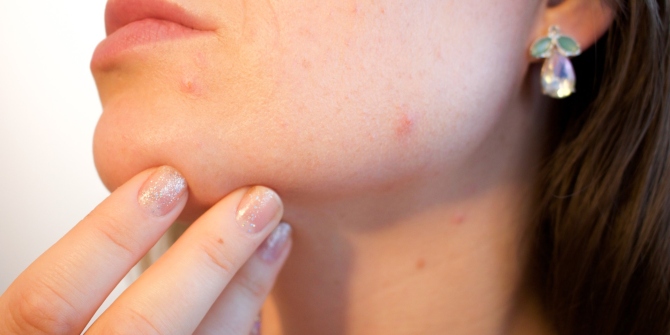
Acne has been the scourge of teenage boys and girls for as long as there have been teenagers. Indeed, acne is the eighth most common disease among humans, affecting nearly 650 million people worldwide. But might acne have a silver lining?
Economists are increasingly interested in the economic returns to physical attractiveness, an interest largely ignited by Hamermesh and Biddle (1994). Recently, economists have estimated the returns to particular aspects of physical attractiveness, including facial attractiveness, height and weight, hair colour, and clothing.
Bóo, Rossi, and Urzúa 2013, Scholz and Sicinski 2015, Harper 2000, Deaton and Arora 2009, Cawley 2004, Johnston 2010, Hamermesh, Meng, and Zhang 2002, French et al. 2009 and Deryugina and Shurchkov 2015 find that measures of physical attractiveness are negatively correlated with overall grade point average (GPA) in high school and scores on standardised college admissions tests. Hernández-Julián and Peters (2017) find that both female students with below-average and above-average ratings of attractiveness earn lower grades, suggesting an inverted U-shape relationship between physical appearance and grades in college.
In a new paper, we extend the literature examining the effects of physical attractiveness on education and labour market earnings by considering acne. We provide the first evidence on the relationship between having acne in middle to high school and subsequent educational and labour market outcomes. We focus on acne for two main reasons. First, acne is a more precisely-defined and objective condition compared to ratings of physical attractiveness, and second, acne is very common — it afflicts about 60 to 68 per cent of young persons between the ages of 15 and 19. We find that having acne is positively associated with overall GPA in high school, grades in high-school English, history, math, and science, and the completion of a college degree. We also find evidence that acne is associated with higher personal labour market earnings for women.
We use a unique, nationally representative survey dataset from the National Longitudinal Study of Adolescent to Adult Health (Add Health). Add Health surveyed a cohort of early-to-mid teenagers in 1994-1995 and followed up with three additional waves in 1996, 2001-2002 and 2007-2008. Importantly for our research, the first wave of Add Health included questions about individuals’ skin conditions, as well as detailed questions about self-esteem, social acceptance, participation in clubs and other organisations, grades, information about the individuals’ schools, and demographics and family characteristics. Later waves include information about overall high school performance, post-secondary education, and careers and earnings. This allows us to connect individuals’ responses about the prevalence of skin conditions in their teens to their later high school GPAs, highest levels of education completed, and labour market outcomes.
Why is acne associated with higher grades and educational outcomes? In theory, having acne may reduce attractiveness and feelings of being socially accepted, thereby reducing time spent socialising and increasing time spent studying. We find that acne reduces the Add Health interviewer’s perceptions regarding a student’s appearance and personality. We further find that acne reduces a student’s perceptions of having good qualities and feeling socially accepted. Finally, we find that, while having acne reduces participation in sports clubs, it increases participation in non-sports clubs. Put together, acne induces a shift from non-intellectual and social pursuits to more-intellectual pursuits, which may be conducive to higher grades and educational attainment.
Our results also suggest a possible non-monotonicity in the relationship between acne and earnings. While severe acne is related to higher grades in high school, we find that “occasional” (i.e., less severe) acne is most strongly related to longer-term labour-market outcomes. We hypothesise that severe acne limits socialisation so much as to affect long-term outcomes that may depend both on studying and on sociability.
Importantly, we also provide evidence that the correlations we find between acne and educational and labour market outcomes may be causal. While acne is strongly related to fixed and observable characteristics, including gender, race, and age, it is not related to measures of socioeconomic status, including parental education levels or most measures of family structure. This provides evidence that it is acne which affects individuals’ education and labour market outcomes, rather than the reverse.
Focusing on acne has the potential to advance the literature on the returns to physical attractiveness since acne is a precisely-defined medical condition and is arguably a less subjective measure than general physical appearance. The results of our paper may offer solace to teenagers suffering from acne. While acne in adolescence is likely to subside, the benefits of higher educational attainment may last a lifetime.
♣♣♣
Notes:
- This blog post is based on the authors’ paper Do Pimples Pay? Acne, Human Capital, and the Labor Market, Journal of Human Capital, Spring 2019.
- The post gives the views of its authors, not the position of LSE Business Review or the London School of Economics.
- Featured image by Kjerstin_Michaela, under a Pixabay licence
- When you leave a comment, you’re agreeing to our Comment Policy.
 Hugo Mialon is an associate professor and director of undergraduate studies in the department of economics at Emory College of Arts and Sciences. His basic field of research is microeconomics. He specialises in interdisciplinary work at the boundaries between economics and other social sciences. He is currently pursuing research in four main areas: economics and sociology; law and economics; health economics; and industrial organisation.
Hugo Mialon is an associate professor and director of undergraduate studies in the department of economics at Emory College of Arts and Sciences. His basic field of research is microeconomics. He specialises in interdisciplinary work at the boundaries between economics and other social sciences. He is currently pursuing research in four main areas: economics and sociology; law and economics; health economics; and industrial organisation.
 Erik Nesson is an associate professor of economics at Ball State University. His research interests include health economics, law and economics, and labour economics. Dr. Nesson’s current projects include measuring the effects of public policies on risky behaviours such as smoking, alcohol use, and tobacco use, examining the relationship between education and health, and developing new methods to measure health inequality.
Erik Nesson is an associate professor of economics at Ball State University. His research interests include health economics, law and economics, and labour economics. Dr. Nesson’s current projects include measuring the effects of public policies on risky behaviours such as smoking, alcohol use, and tobacco use, examining the relationship between education and health, and developing new methods to measure health inequality.






2 Comments